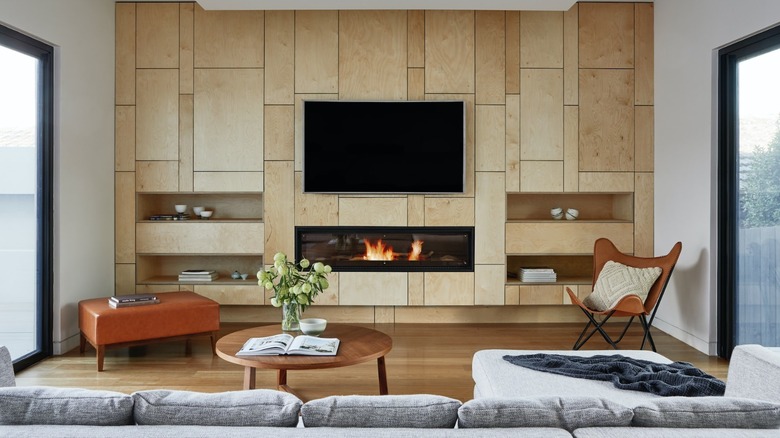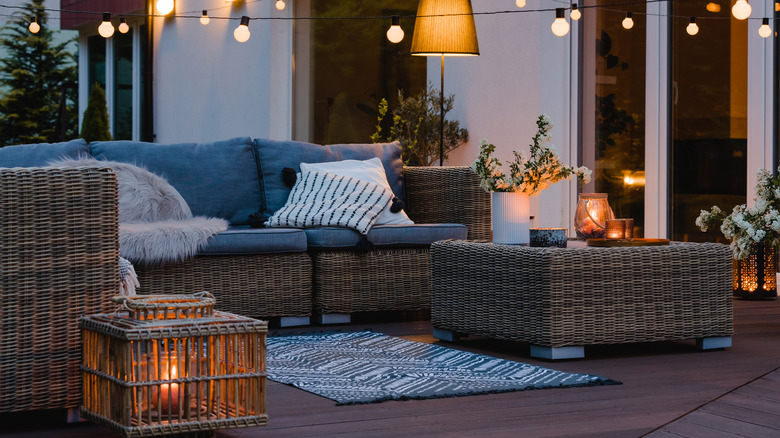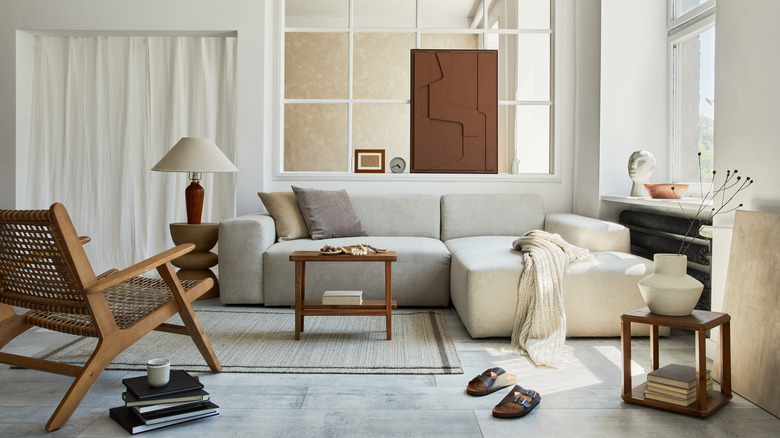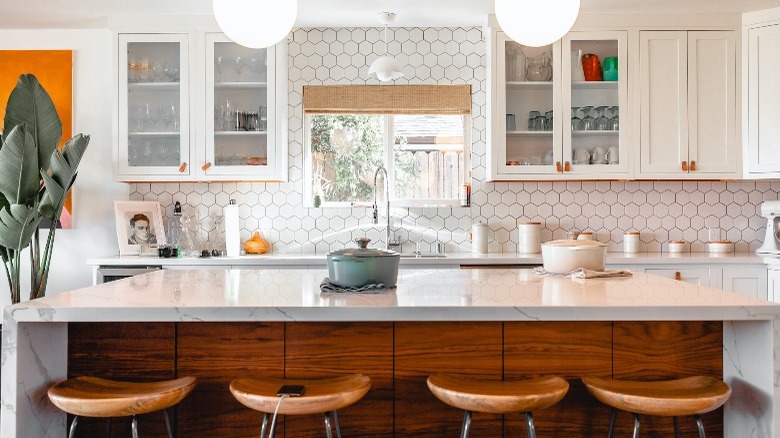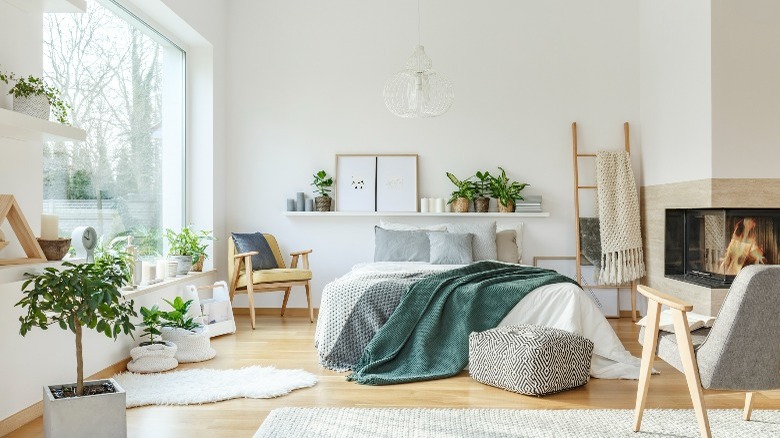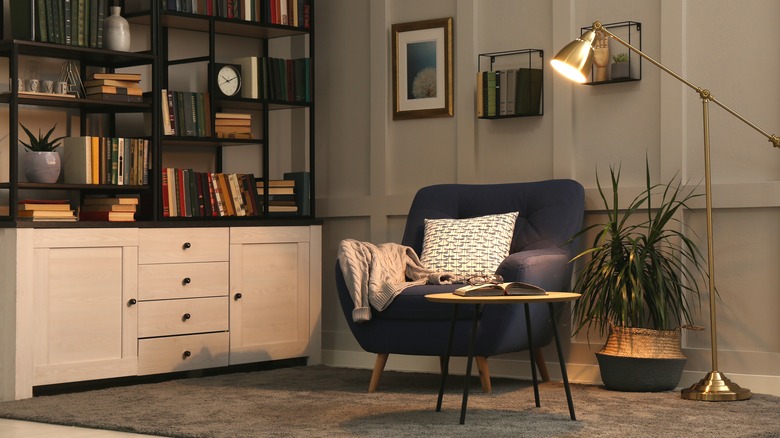What Is The Slow Living Home Design Trend?
One could say that slow living home design is anti-decorating, having more to do with living lightly and representing our true selves inside our homes, where we spend time relaxing with family or pursuing interests and hobbies. Rather than being carefree, it means we care a lot, but about things like good air quality, comfort, and a restorative environment. Slow Living LDN calls the slow home a more considered home. The needs-driven and personal approach dismisses the idea of competition between peers or neighbors, whether regarding square footage, aesthetics, or the cost of objects that fill up our interior worlds.
The concept shares roots with the Slow Food Movement, which started almost four decades ago and praises the physical and mental benefits of cooking from whole fresh ingredients with focused attention on the process rather than the clock, per Love to Know. Furthermore, the slow home is a direct offshoot of the slow living mindset, encompassing more conscious behavior, connection to nature, and simplification.
A search of the hashtag #slowhome reveals tidy decor, curated coffee time, and thriving houseplants. On social media, the expectation feels slightly oxymoronic rather than aspirational. We might wonder, "If my home doesn't look this way, am I doing something wrong?" Suddenly, what's meant to be low-pressure begins to feel complicated. Without being prescriptive, we'd like to offer some ideas to make home less stressful and more joyful. If we can stop ourselves from comparing our serenity to that of others, the rest will surely follow.
It's the little things
Green Lili creative specialist Michelle Collins explains slow living at home. "At its core, it's a way of life that celebrates the little things," she tells Country Living. "Adopt the Danish way of living by bringing a little hygge (pronounced hue-guh) to your home." Similarly, Meik Wiking, CEO of the Happiness Research Institute in Copenhagen (via Self) says, "The true essence of hygge is the pursuit of everyday happiness ... it's basically like a hug, just without the physical touch."
Danish hygge is akin to Japanese ikigai, per Babbel. They relate to the significance of small rituals and trivial moments, and the ability of those to help build a comfortable, meaningful life. Both words roughly translate to cozy and present; the pleasure in a warm cup of coffee, a glowing candle, or a thick pair of cushy socks are fine examples.
Self suggests creating an inviting atmosphere with candles and layered textiles. In combination with setting aside time to indulge in a long-simmered stew or a homemade sweet treat and wrapping up in cozy clothing, it seems that Wiking's hug metaphor is perfectly apt. If you're in a social mood, have friends and family over to share in the feeling. We can also receive the benefits of being outdoors while hygge-ing our exterior areas; Cube Smart notes a fire pit is a must-have along with plenty of blankets and warm beverages.
Set a soothing environment
Green Lili recommends subdued color palettes in our homes for their calming effects, specifically light tones and natural schemes. According to Natalie Craig Design, the penchant for neutral shades to act as a quiet complement to interior elements creates simplicity, manifested in the look and the skill needed to harmoniously incorporate different components. Light neutrals also give the impression of space and cleanliness. For those craving more color, adding accents with artwork, textiles, and decor is an easy solution.
Creating the type of home that speaks to you personally is an important tenet of the slow home living philosophy, says Slow Living LDN. If bold color makes you supremely happy, neutral tones may engender boredom. The outlet explains alternate options for a serene atmosphere, such as monochromatic color stories (those using various tints of one color), and painting the walls and ceiling the same shade, which eliminates a jarring break between opposing treatments and imparts a feeling of expansiveness instead. Additionally, dark spaces can read as cozy and intimate, equating to a sense of ease.
Finally, Green Lili encourages a clutter-free environment for peak relaxation. Too much stuff can make us feel overwhelmed, while cleaning it allows less time for more joyful pursuits. The proprietor of Slow Norfolk, vacation rentals designed to provide a restorative time-out, told Slow Living LDN, "Simplicity is key. Resisting the urge to clutter a space ... and keeping to an effortlessly minimalist style helps to exude a calming sense of tranquillity."
Buy better
According to Slow Living LDN, creating a considered home requires us to be thoughtful about what we buy for our spaces, first asking if prospective purchases are truly necessary. This is, in a sense, the antithesis of mass consumption and needless accumulation. Investing in the best quality items we can afford will help deter repeated purchases.
In addition, the outlet suggests that caring for pieces we already own is a function of slow living; this could mean anything from setting up revolving maintenance schedules for home systems to washing delicate clothing by hand. Green Lili recommends choosing sustainably made and second-hand items for their reduced environmental impact, and supporting brands whose business and manufacturing practices align closely with our values.
A slow home is also a healthful home, therefore using natural and non-toxic products within its walls is key. Furniture, mattresses, and carpeting can release harmful compounds within our interiors. Cleaning and beauty products, kitchenware, and scented candles are additional everyday items that affect indoor air quality. Among ideas offered by Pure Living Space for how to make our homes healthier, organic bedding and textiles, low or even zero VOC paints and stains, beeswax instead of paraffin candles, and cast-iron instead of nonstick pans are suggested. Formaldehyde is another indoor air pollutant that is frequently used in the manufacture of pressed wood furniture; buying solid wood, secondhand, or antique furniture for our homes can help lessen our exposure to the chemical.
Create connections to nature
Slow home design positively characterizes abundant natural light, organic materials, and views of the outdoors as benefits to our wellbeing. Surrounding ourselves with these elements connects us to nature. It can be such a desirable and essential state that biophilic design, which seeks to best utilize our relationships with the natural world, is a significant developing trend in residential and commercial architecture and interior design.
We can easily and affordably mine some of these concepts for our home decor, including the introduction of wood, stone, wool, and organic cotton by way of upholstery, flooring, countertops, and finishes. Small objects can inspire a tether to nature too: stoneware teacups, wooden cutting boards, a collection of beach pebbles, and artwork featuring landscapes and plant motifs, for example.
From a decorating perspective, houseplants add vibrancy and texture, yet it's not just about aesthetics; according to Healthline, they also increase focus and energy while lowering stress levels.
To maximize natural light, ensure drapery and decor don't obstruct the windows. Per Healthline, natural light promotes better sleep and aids in relieving seasonal depression. To that end, Green Lili suggests keeping curtains open during daylight hours and placing mirrors opposite windows to reflect light into the room. Consider arranging furniture so you can take in the views while relaxing as well. What's more, opening your home's windows can be an optimal way to improve indoor air quality (via Pure Living Space) and it creates an auditory link to the outdoors.
Retreat yourself
Slow Living LDN explains that slow homes embrace the concept of designing with the intended functions for each space and the personality of its occupants as the overriding motivations. This sounds simple enough, but often, we get caught up in the acquisition of goods and decorating for the wrong reasons, such as following a trend or cashing in on a good deal. The outlet notes that interiors which have been decorated hastily or without due consideration might not satisfy certain requirements, hence, they won't be used to their full potential. By the same token, adequate lighting, comfortable seating, and functionality will contribute to a room that feels welcoming.
Leaning into this idea, Green Lili emphasizes the importance of having a retreat area — a quiet and safe place where outside concerns can be left behind after a stressful day. It might be a separate room or just a corner chair. Slow Living LDN notes the area should be free of visual distraction, or at least as tidy as possible. Just as with hygge, a cozy spot with some comforting textiles and soft lighting can help to focus attention on the present. But avoid the urge to use the space to scroll, and opt to unplug instead.
